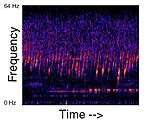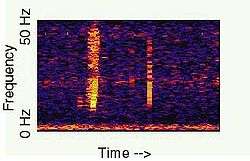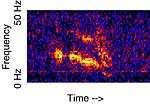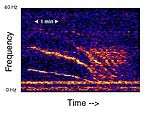List of unexplained sounds
The following is a list of unidentified, or formerly unidentified, sounds. All of the sound files in this article have been sped up by at least a factor of 16 to increase intelligibility by condensing them and raising the frequency from infrasound to a more audible and reproducible range.
NOAA (unidentified)
The following unidentified sounds have been detected by the USA National Oceanic and Atmospheric Administration using its Equatorial Pacific Ocean autonomous hydrophone array.
Upsweep

 |
|
| Problems playing this file? See media help. | |
Upsweep is an unidentified sound detected on the American NOAA's equatorial autonomous hydrophone arrays. This sound was present when the Pacific Marine Environmental Laboratory began recording its sound surveillance system SOSUS in August, 1991. It consists of a long train of narrow-band upsweeping sounds of several seconds in duration each. The source level is high enough to be recorded throughout the Pacific.
The sound appears to be seasonal, generally reaching peaks in spring and autumn, but it is unclear whether this is due to changes in the source or seasonal changes in the propagation environment. The source can be roughly located at 54°S 140°W / 54°S 140°W, near the location of inferred volcanic seismicity, but the origin of the sound is unresolved. The overall source level has been declining since 1991, but the sounds can still be detected on NOAA's equatorial autonomous hydrophone arrays.[1]
Whistle
.jpg)
 |
|
| Problems playing this file? See media help. | |
According to NOAA, the Whistle is similar to volcanogenic sounds previously recorded in the Mariana volcanic arc of the Pacific ocean, but since it was only recorded on one hydrophone rather than the three required to triangulate a location, it is considered "unidentified".[2]
NOAA (formerly unidentified)
Bloop

Bloop is the name given to an ultra-low-frequency and extremely powerful underwater sound detected by the U.S. National Oceanic and Atmospheric Administration (NOAA) in 1997. The sound is consistent with the noises generated by icequakes in large icebergs, or large icebergs scraping the ocean floor.[3]
Analysis
The sound's source was roughly triangulated to a remote point in the south Pacific Ocean west of the southern tip of South America, and the sound was detected several times by the Equatorial Pacific Ocean autonomous hydrophone array.[3]
 |
|
| Problems playing this file? See media help. | |
According to the NOAA description, it "rises rapidly in frequency over about one minute and was of sufficient amplitude to be heard on multiple sensors, at a range of over 5,000 km (3,100 mi)." The NOAA's Dr. Christopher Fox did not believe its origin was man-made, such as a submarine or bomb, nor familiar geological events such as volcanoes or earthquakes. While the audio profile of Bloop does resemble that of a living creature,[4] the source was a mystery both because it was different from known sounds and because it was several times louder than the loudest recorded animal, the blue whale.[5]
The NOAA Vents Program has attributed the sound to that of a large icequake. Numerous icequakes share similar spectrograms with Bloop, as well as the amplitude necessary to spot them despite ranges exceeding 5,000 km (3,100 mi). This was found during the tracking of iceberg A53a as it disintegrated near South Georgia island in early 2008. If this is indeed the origin of Bloop, the iceberg(s) involved in generating the sound were most likely between Bransfield Straits and the Ross Sea; or possibly at Cape Adare, a well-known source of cryogenic signals.[3]
Julia

 |
|
| Problems playing this file? See media help. | |
Julia is a sound recorded on March 1, 1999 by the U.S. National Oceanic and Atmospheric Administration (NOAA). NOAA said the source of the sound was most likely a large iceberg that had run aground off Antarctica. It was loud enough to be heard over the entire Equatorial Pacific Ocean autonomous hydrophone array. The unidentified sound lasted for about 15 seconds. Due to the uncertainty of the arrival azimuth, the point of origin could be between Bransfield Straits and Cape Adare.[6]
Slow Down

 |
"Slow Down", at 16 times its original speed.
|
| Problems playing this file? See media help. | |
Slow Down is a sound recorded on May 19, 1997, in the Equatorial Pacific Ocean by the U.S. National Oceanic and Atmospheric Administration. The source of the sound was most likely a large iceberg as it became grounded.[7]
Analysis
The name was given because the sound slowly decreases in frequency over about 7 minutes. It was recorded using an autonomous hydrophone array.[8] The sound has been picked up several times each year since 1997.[9] One of the hypotheses on the origin of the sound is moving ice in Antarctica. Sound spectrograms of vibrations caused by friction closely resemble the spectrogram of the Slow Down. This suggests the source of the sound could have been caused by the friction between a large ice sheet moving over land.[9]
Train

The Train is the name given to a sound recorded on March 5, 1997 on the Equatorial Pacific Ocean autonomous hydrophone array. The sound rises to a quasi-steady frequency. According to the NOAA, the origin of the sound is most likely generated by a very large iceberg grounded in the Ross Sea, near Cape Adare.[10]
 |
|
| Problems playing this file? See media help. | |
Other
- Colossi of Memnon, at which a sound was probably caused by rising temperatures and the evaporation of dew inside the porous rock of the statue.[11]
- Unusual noises heard near One World Trade Center, attributed to wind moving through and around the unfinished building. Strange 'wailing' noises were reported during the transit of Hurricane Sandy, while the building was still under construction.[12]
- Bio-duck, a sound that is produced by the Antarctic minke whale.[13][14]
- The Ping, described as "acoustic anomalies" whose "sound[s] scare sea animals," being investigated by Canadian military authorities.[15]
Non-specific
- The Hum
- Mistpouffers or Skyquakes, a phenomenon generally occurring near large bodies of water. Sound has been compared to distant cannonfire or thunder.
See also
Notes
References
- ↑ "Upsweep". National Oceanic and Atmospheric Administration. Retrieved 2011-08-20.
- ↑ "Whistle". National Oceanic and Atmospheric Administration. Retrieved 2011-08-20.
- 1 2 3 "Acoustics Monitoring Program - Icequakes (Bloop)". Pacific Marine Environment Laboratory. NOAA.gov. Retrieved 2012-11-17.
- ↑ Wolman, David (2002-06-15). "Calls from the deep". New Scientist. Archived from the original on 2013-01-06. Retrieved 2012-01-16.
- ↑ "Animal Records". Smithsonian National Zoological Park. Retrieved 2010-09-26.
- ↑ "Acoustics Monitoring Program". pmel.noaa.gov. 1999-03-01. Retrieved 2012-11-12.
- ↑ NOAA Cryogenic "Slow Down"
- ↑ NOAA page
- 1 2 David Wolman (15 June 2002). "Calls from the deep". New Scientist. p. 35. Archived from the original on 6 January 2013.
- ↑ "Iceberg Grounding (Train)". NOAA. Retrieved 24 October 2012.
- ↑ Lord Curzon (1923). The Voice of Mnemon - Tales of Travel.
- ↑ One World Trade Center Makes Strange, Ghostly Sounds In Lower Manhattan (VIDEOS), Huffington Post
- ↑ Risch, D.; Gales, N. J.; Gedamke, J.; Kindermann, L.; Nowacek, D. P.; Read, A. J.; Siebert, U.; Van Opzeeland, I. C.; Van Parijs, S. M.; Friedlaender, A. S. (2014). "Mysterious bio-duck sound attributed to the Antarctic minke whale (Balaenoptera bonaerensis)". Biology Letters. 10 (4): 20140175. PMC 4013705
 . PMID 24759372. doi:10.1098/rsbl.2014.0175.
. PMID 24759372. doi:10.1098/rsbl.2014.0175. - ↑ Rob McCauley; John Bannister; Chris Burton; Curt Jenner; Susan Rennie; Chandra Salgado Kent (October 2004). Western Australian Exercise Area Blue Whale Project, Final Summary Report, Milestone 6 (PDF) (Report). Australian Defence. Retrieved 2012-06-26.
A signal type widely heard by Navy submariners and known as the bioduck is common in the [Perth] Canyon during late July-Dec [1999-2004]. The seasonal timing of the bioduck is similar to other great whales which migrate up from Antarctic waters.
- ↑ Canadian military investigating mysterious 'ping' sound scaring sea animals